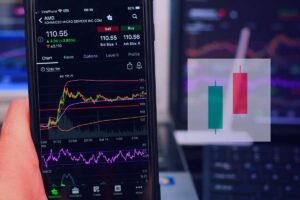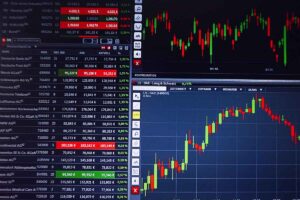What is a Stock Exchange?
A stock exchange is a centralized financial marketplace where individuals and institutions can buy and sell various financial instruments, primarily stocks (equity securities), bonds, commodities, and derivatives. These exchanges operate under specific rules and regulations, and they serve as organized and regulated marketplaces for the trading of securities.
To trade on a stock exchange, a company must go through an initial listing process. This involves meeting specific requirements set by the exchange, including financial disclosure, corporate governance standards, and more. Once approved, the company’s shares become listed and can be traded on the exchange.
Stock exchanges employ sophisticated electronic trading systems to match buy and sell orders. When a buy order aligns with a sell order at the same price, a trade is executed. Stock exchanges play an important role in the process of price discovery, where prices are determined by the forces of supply and demand, reflecting the collective knowledge and expectations of market participants.
Stock exchanges provide real-time market data, including current stock prices, trading volumes, bid-ask quotes, and historical price information. This data is essential for investors and traders to make informed decisions. Once a trade is executed, the exchange ensures that it undergoes the clearing and settlement process, guaranteeing that the buyer obtains the shares and the seller receives the funds. This process often involves a clearing house that acts as an intermediary, reducing counterparty risk.
Stock Exchange Definition
A stock exchange is a regulated financial marketplace where various financial instruments, primarily stocks (equity securities), bonds, commodities, and derivatives, are bought and sold. It serves as a centralized platform where investors, including individual and institutional investors, come together to trade securities in accordance with established rules and regulations.
Stock exchanges are regulated by government authorities and securities commissions to maintain market integrity, protect investors, and ensure fair and transparent trading practices. Regulatory bodies, such as the U.S. Securities and Exchange Commission (SEC) in the United States, establish rules and regulations that govern the operations of stock exchanges and their participants.
Stock exchanges often have benchmark indices, such as the S&P 500 or the FTSE 100, which track the performance of a representative sample of stocks. These indices provide insights into the overall health and performance of the market.
How Stock Exchanges Work
Stock exchanges facilitate the trading of various financial instruments, including common stocks, preferred stocks, bonds, exchange-traded funds (ETFs), and derivatives.
Following is a simplified overview of what actually happens in the Stock exchanges:
1. Listing of Shares by Companies
Stock exchanges establish specific requirements and criteria that a company must satisfy to become listed. The company interested in listing submits an application to the stock exchange, detailing its qualifications and compliance with the exchange’s listing requirements. Once approved, the company’s shares are officially listed on the exchange, and investors can buy and sell these shares on the exchange’s trading platform.
2. Market Participants
Stock exchanges are open to a wide range of participants, including individual retail investors, institutional investors (like mutual funds and pension funds), market makers, and high-frequency traders. These participants play different roles in the market, from providing liquidity to executing trades.
3. Market Data
Stock exchanges provide real-time market data, including current stock prices, trading volumes, bid-ask quotes, and historical price information. This data is essential for investors and traders to make informed decisions.
4. Orders & Order Types
Buyers and sellers place orders through brokerage firms, either online or in traditional brokerage offices. Investors can place different types of orders when trading on a stock exchange. Common order types include market orders (buy or sell at the current market price), limit orders (buy or sell at a specific price), and stop orders (execute when a certain price is reached).
5. Matching Buyers and Sellers & Order Execution
Stock exchanges use sophisticated electronic trading systems to match buy and sell orders. The bid price represents the highest price a buyer is willing to pay, while the ask price is the lowest price a seller is willing to accept. When a buy order matches with a sell order at the same price, a trade is executed.
6. Clearing and Settlement
Once a trade is executed, the exchange ensures that the trade is cleared and settled, meaning the buyer gets the shares, and the seller receives the funds. This process often involves a clearing house that acts as a middleman, reducing counterparty risk.
Types of Stock Exchanges
1. Based on Trading Methods and Technology
Stock exchanges can be classified based on trading methods and technology into three primary categories: Auction markets, Electronic exchanges, and Dealer markets.
a. Auction Markets
Auction markets are traditional stock exchanges where the buying and selling of securities occur through an auction system. In these exchanges, human traders, also known as floor traders, facilitate the execution of orders by matching buyers and sellers on the trading floor. Many auction markets have since transitioned to electronic trading to keep pace with technological advancements.
Examples:
New York Stock Exchange (NYSE): Historically, the NYSE operated as a prominent auction market, with traders conducting open outcry trading on the exchange floor. While it has transitioned to electronic trading, it still retains some elements of its traditional auction model.
Euronext: Euronext operates as a group of stock exchanges in Europe, and still operates traditional auction markets across multiple European cities.
b. Electronic Exchanges
Electronic exchanges are fully electronic platforms where buy and sell orders are matched using computer algorithms and automated systems. Orders are executed electronically and efficiently without the need for a physical trading floor or intermediaries. Most of the modern exchanges are electronic type. They are known for their speed, efficiency, and ability to handle high trading volumes.
Examples:
NASDAQ: A major electronic exchange known for its technology-driven approach to trading stocks and options.
Chicago Mercantile Exchange (CME): An electronic exchange specializing in the trading of futures and options contracts.
Euronext: Operates electronic trading platforms in multiple European countries, alongside traditional auction markets.
c. Dealer Markets
In dealer markets, trading occurs through market makers, dealers, or specialists who act as intermediaries between buyers and sellers. Dealers maintain an inventory of securities and provide liquidity by offering bid and ask prices for those securities.
Examples:
Bond Market: The bond market relies on dealers to match buyers and sellers in the trading of bonds.
Over-the-Counter (OTC) Markets: OTC markets involve dealers who facilitate trading in various financial instruments, including stocks and derivatives.
Foreign Exchange Markets: Major international banks and financial institutions act as market makers, offering bid and ask prices for currency pairs.
2. Based on Specialization
Stock exchanges can be classified based on their specialization into the following categories:
Equity Exchanges: These exchanges primarily focus on the trading of common and preferred stocks issued by publicly traded companies. Examples include the New York Stock Exchange (NYSE) and NASDAQ in the United States, Euronext in Europe, and the Tokyo Stock Exchange (TSE) in Japan.
Commodity Exchanges: These exchanges specialize in the trading of commodities and commodity derivatives, including agricultural products (e.g., wheat, corn), energy resources (e.g., crude oil, natural gas), and precious metals (e.g., gold, silver). Notable commodity exchanges include the Chicago Mercantile Exchange (CME) and the Intercontinental Exchange (ICE).
Currency Exchanges: Also known as foreign exchange (Forex) markets, these exchanges facilitate the trading of various currencies and currency pairs. The forex market is decentralized, with a network of interbank exchanges and electronic trading platforms like EBS and Reuters Matching.
Bond Exchanges: Bond exchanges specialize in the trading of various types of fixed-income securities, such as government bonds, corporate bonds, municipal bonds, and other debt instruments. Examples include the Chicago Board of Trade (CBOT) and the London Stock Exchange’s bond market.
Derivatives Exchanges: These exchanges focus on the trading of derivative instruments, including options and futures contracts. Examples include the Chicago Board Options Exchange (CBOE), Eurex, and the Hong Kong Futures Exchange (HKFE).
Options Exchanges: Options exchanges specialize in the trading of options contracts, which grant the right, but not the obligation, to buy or sell an underlying asset at a specified price (strike price) on or before a predetermined expiration date. The CBOE and NYSE American Options are prominent options exchanges.
Cryptocurrency Exchanges: With the rise of cryptocurrencies like Bitcoin and Ethereum, specialized cryptocurrency exchanges have emerged. These exchanges enable the buying and selling of various cryptocurrencies and digital assets. Well-known cryptocurrency exchanges include Coinbase, Binance, and Kraken.
3. Based on Geographical Location
Based on their geographical location, stock exchanges are classified into Regional, National, and Global Exchanges.
National Stock Exchanges: These operate within a single country, serving domestic companies and investors.
Regional Stock Exchanges: Some countries have regional or local stock exchanges serving specific geographic areas.
Global Stock Exchanges:These cater to companies and investors from multiple countries.
Listing of Securities in Stock Exchange
There are two primary approaches that companies can adopt, while seeking to raise capital and make their shares available for public trading on a stock exchange.
- Initial Public Offering (IPO)
- Direct Public Offering (DPO) or Direct Listing
Initial Public Offering (IPO)
IPOs have been the conventional method for companies to go public for many years.
In an IPO, the company creates and issues new shares of its stock in the primary market. These new shares are then sold to the public for the first time. Once these shares are purchased by investors in the primary market, they can be traded on the secondary market (stock exchanges), where investors can buy and sell them among themselves.
Companies going public through an IPO must adhere to regulatory requirements and undergo a thorough vetting process by regulatory authorities, such as the U.S. Securities and Exchange Commission (SEC) for companies in the United States. The company typically hires investment banks or underwriters to facilitate the IPO. These underwriters help the company determine the IPO price, prepare the necessary documentation, and market the shares to potential investors.
Once the company has completed the necessary preparations and obtains regulatory approval, it decides on the stock exchange on which it wishes to list its shares.
The stock exchange undertakes a thorough review of the application and the accompanying documents. This process is designed to ensure that the company is in compliance with the exchange’s listing requirements and regulatory standards. If approved, the company’s shares will be permitted to be traded on the exchange.
Once the company’s application is approved by both the regulators and the stock exchange, it can proceed with the public offering. On the designated IPO day, shares are sold to investors who want to purchase them. After the IPO, the stock begins trading on the exchange under a designated ticker symbol.
Direct Public Offering (DPO) or Direct Listing
A DPO or direct listing is a less conventional approach for companies to go public but is gaining in popularity recently.
In a direct listing, the company does not create or issue new shares. Instead, it allows existing, outstanding shares held by insiders, employees, and early investors to be traded on a public exchange. This means no new capital is raised through the listing process.
DPOs are often chosen by companies seeking a more cost-effective and transparent way to become publicly traded. They can bypass underwriting fees and some of the administrative complexities associated with an IPO.
DPOs are more commonly used by well-established, mature companies that do not require additional capital at the time of going public and have a strong existing shareholder base. Notable examples that opted for a direct listing include Spotify Technology and Slack.
Listing Criteria
Listing criteria, also known as listing requirements, are the specific standards and conditions that companies must meet to have their securities (such as stocks or bonds) listed and traded on a stock exchange. These criteria are established to ensure the quality, transparency, and reliability of the companies listed on the exchange.
While the specific listing requirements may vary from one stock exchange to another, here are some common criteria that companies are typically expected to meet:
1. Financial Criteria
Earnings and Revenue: Exchanges often require a minimum level of earnings or revenue to demonstrate the company’s financial stability.
Shareholder Equity: A minimum level of shareholder equity may be required to ensure that the company has a solid financial base.
Market Capitalization: Exchanges might set a minimum market capitalization (total market value of outstanding shares) for companies seeking listing.
Minimum Stock Price: Companies may need to maintain a minimum stock price, often referred to as a price floor, to prevent the listing of extremely low-priced or penny stocks.
2. Corporate Governance and Compliance
Compliance with Securities Laws: Companies must comply with relevant securities laws and regulations.
Board Independence: Some exchanges require a certain percentage of independent directors on the company’s board.
Audit and Financial Reporting: Companies should meet strict financial reporting standards and use reputable auditing firms for their financial statements.
Disclosure Requirements: Companies must adhere to disclosure rules, ensuring that they provide timely and accurate information to the public.
Reporting: Companies must provide regular financial reports, including audited financial statements, and comply with disclosure standards. They should also make timely filings with the exchange, including annual reports and quarterly updates.
3. Trading Activity
Minimum Trading Volume: Exchanges may require a minimum level of trading activity, such as a certain number of shares traded per day.
Public Float: A portion of the company’s outstanding shares should be available for trading by the public, not held by insiders or restricted from trading.
4. Listing Fees and Costs
Listing Fees: Companies must pay listing fees to the exchange, which can vary based on the size and location of the company. These fees cover the exchange’s administrative and regulatory costs.
Major Stock Exchanges in the World
Some of the major and most well-known stock exchanges include:
- New York Stock Exchange (NYSE)
Located in the United States, the NYSE is one of the largest and most prestigious stock exchanges globally. It lists many of the world’s leading companies. As of December 2022, it has an equity market capitalization of nearly 23 trillion U.S. dollars.
- NASDAQ (National Association of Securities Dealers Automated Quotations)
Also based in the United States, NASDAQ is known for its technology-focused listings, including giants like Apple and Amazon. It is the second-largest stock exchange in the world. As of December 2022, the equity market capitalization of NASDAQ exceeded 16 trillion U.S. dollars.
- Shanghai Stock Exchange (SSE)
SSE is the largest stock exchange in China and the third largest in the world as of December 2022, with an equity market capitalization of nearly 7 trillion U.S. dollars.
- Euronext
Euronext is a pan-European stock exchange and the largest one in Europe. Euronext operates multiple stock exchanges across Europe, including Amsterdam, Brussels, Lisbon, Milan, Oslo, and Paris. And as of December 2022, Euronext Stock Exchange of Europe ranked below the Shanghai Stock Exchange of China, in the fourth position.
Other major stock exchanges include:
- London Stock Exchange (LSE): Situated in the United Kingdom, LSE is one of the oldest and most influential stock exchanges in the world.
- Tokyo Stock Exchange (TSE): As Japan’s primary stock exchange, TSE is a key player in the Asian market and is home to many Japanese corporations.
- Hong Kong Stock Exchange (HKEX): HKEX lists many international companies alongside Asian giants.
- Toronto Stock Exchange (TSX): As Canada’s main stock exchange, TSX lists a wide range of companies, including those in the resource and energy sectors.
- BSE (Bombay Stock Exchange): BSE is the oldest stock exchange in Asia and is based in India.










